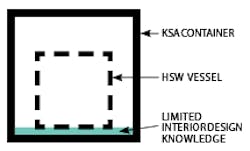NCIDQ News: Filling the HSW Vessel
By Deborah Steinmetz
To write this article accurately, it is first important to define what I mean when I use the term "interior designer." By interior designer, I mean an individual who has at least six years of combined education and experience in interior design, including experience working for a qualified practitioner. It's important to define the term, interior designer, this way because it is widely used by the media and public to identify anyone from a fashion designer who styles homes to a decorative painter.
In order to be a qualified interior designer, an individual must obviously possess certain knowledge, skills and abilities (KSAs), and NCIDQ, as the qualification organization, has defined which of these knowledge, skills and abilities are critical to protect the public. These well-defined KSAs are what NCIDQ tests on the examination.
Visualize a large empty container. In the middle of the container is a smaller vessel. Imagine that the container is filled with all of the KSAs that an interior designer must have to practice his or her profession. The smaller vessel, likewise, is filled—but only with those KSAs that affect the public's health, safety and welfare (HSW). The NCIDQ Examination does not test everything in the larger container; it tests only the contents of the smaller vessel.
When students begin a professional interior design degree program, they have limited KSAs applicable to practicing interior design; their large container is empty (see diagram 1). The college curriculum provides a structured education program that organizes learning in a logical sequence, and students move through the program building on knowledge learned as they go. Upon completion of the required program, graduates have a solid foundation of knowledge that is applicable to practicing interior design, but have developed few practical skills and abilities. Imagine that their large container is partially full of knowledge, as is the smaller glass vessel inside.
Working for qualified supervisors, these individuals learn to apply the knowledge gained in school to real-world situations (e.g., develop skills and abilities). A work setting without structure results in haphazard learning; important skills and abilities can be missed. NCIDQ's Interior Design Experience Program (IDEP) provides structure for their ongoing learning. Gaining appropriate experience builds on the base of knowledge accrued during the college years. As individuals build a structured experience, their containers continue to fill. They are getting exposure to all the components of the profession and are acquiring experience in those areas that directly affect the public's well-being. After accumulating the required number of interior design work experience hours, individuals are ready to apply to take the NCIDQ Examination. At this point, the vessel representing knowledge that impacts the public's HSW should be filled (see diagram 2).
Diagram 3. Diagram of KSAs-some are within the HSW vessel; others are not-yet they are all important knowledge areas of a well-rounded interior designer.
Despite what some may believe, the NCIDQ Examination determines minimum competency in interior design with respect to only those aspects of the profession that affect public HSW. How the examination tests health and safety knowledge may be more obvious: building and fire codes, the Americans with Disabilities Act, finish and furniture specifications and sustainability are all subject matter that individuals must know. Welfare may seem less obvious, but it includes anything that affects the well-being of a client and/or building user. Topics include knowing the proper contract language that defines participant roles and project scope; designing to protect the welfare of both clients and future building users; and designing in a way that will enhance the users' experience in the space (e.g., access to natural light, good indoor air quality, properly designed classrooms to improve student learning, well-designed patient rooms to improve healing, etc.).
Diagram 4. Diagram of the container-there is always room for more learning.
In the context of the larger container that includes all the possibilities that an interior design practice may encompass, the exam does not test aspects of the profession unrelated to HSW such as marketing, design history, and purely aesthetic services. These are still very important KSAs for competent interior designers to have—it is just that they do not fall under the purview of protecting the public. It is only those KSAs in the smaller HSW container that are tested (see diagram 3).
Individuals who pass the NCIDQ Examination are said to have "minimum entry-level competence in interior design." This is not the level of ability of recent graduates, nor is it that of seasoned practitioners. It is the level of knowledge that is required, at minimum, to protect the public's health, safety and welfare. Competent interior designers continue learning throughout their lifetimes-either with or without a formal structure. For some people that learning takes the form of a master's degree; for others it means accruing continuing education units. No matter what path they take, individuals are building a body of knowledge—filling the container and vessel within it—to become well-rounded, competent interior designers (see diagram 4).
Deborah Steinmetz is president of NCIDQ. She is an NCIDQ Certificate holder and principal of Steinmetz & Associates, with offices in Atlanta and New Orleans. For more information on NCIDQ, visit www.ncidq.org.
